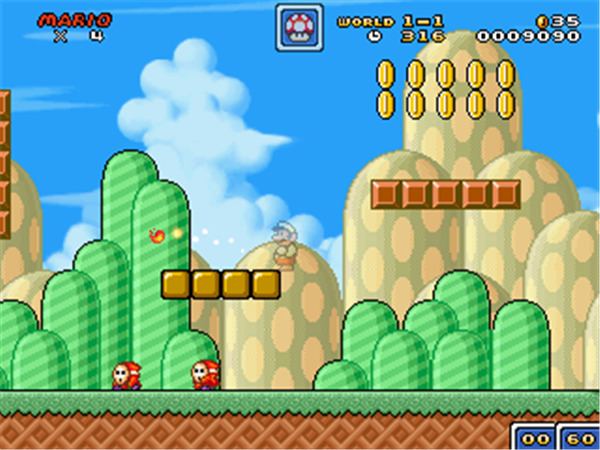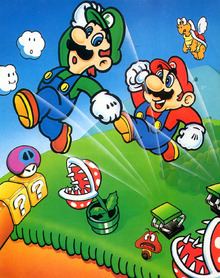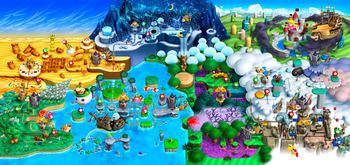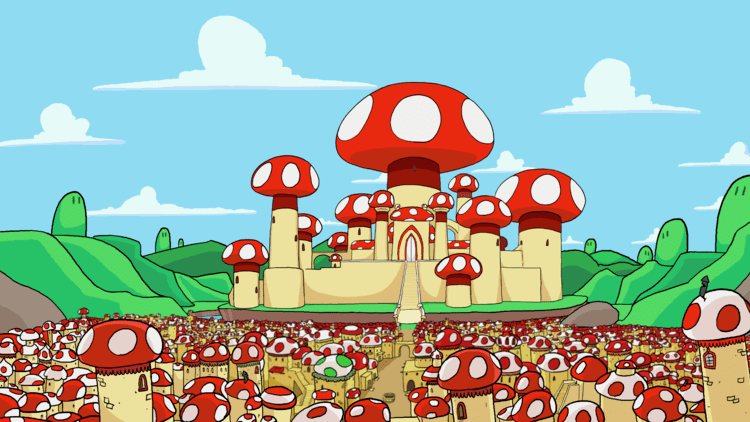Created by Shigeru Miyamoto Type Principality Race(s) Toads First appearance Super Mario Bros. | Genre Video game Ruler Princess Peach Creator Shigeru Miyamoto | |
 | ||
Rise of the mushroom kingdom part 1
The Mushroom Kingdom (キノコ王国, Kinoko Ōkoku) is a fictional setting in Nintendo's Mario series, where most of the games take place.
Contents
- Rise of the mushroom kingdom part 1
- Mushroom kingdom mayhem
- Information
- Government
- Princess Peachs Castle
- Bowsers Castle
- Toad Town
- Landscape
- Transportation
- Technology
- Appearances in other games
- Parodies
- References

Mushroom kingdom mayhem
Information

The Mushroom Kingdom is a monarchy and its heir is Princess Peach in the games. The Chancellor of the kingdom is its head of government in Super Mario RPG. Its capital, as set forth by Paper Mario, is Toad Town. Though Princess Peach and the Mario Brothers are human, the citizens of this area are the mushroom-like Toads (called "Kinopios" in Japan). Some of the Yoshis, dinosaur-like creatures from Dinosaur Land, immigrated into the Mushroom Kingdom shortly after Super Mario World.

The Mushroom Kingdom is often tormented by the Dark Land. Bowser, King of the Koopas, has kidnapped Princess Peach countless times. Initially, it was because she had the power to undo Bowser's handiwork, but in recent games he has developed romantic feelings for the princess. This can be best seen in the original Paper Mario. Games in the Mario series often suggest that the Mushroom Kingdom is a rival of Bowser's domain, the Koopa Kingdom. The Koopa Kingdom has been glimpsed at least five times as the last worlds in Super Mario Bros. 3, Super Mario World 2: Yoshi's Island, and New Super Mario Bros., though several maps and tracks from the Mario Kart and Mario Party series take place here as well. It is also seen in the credits reel of Mario and Luigi: Superstar Saga when they drop off Bowser. It is unknown if the Koopa Kingdom is a completely separate area, or merely a captured portion of the Mushroom Kingdom.
Government

Super Mario Bros. 3 takes place in the "Mushroom World," a collection of seven different kingdoms ruled by independent kings. In the Mario comic books, the physical appearance of the Mushroom King is based on that of the king of Grassland, which is why some people equate it with the Mushroom Kingdom. However, it is unclear what the precise relationship is. The instruction manual for the game states that Bowser had taken over the Mushroom Kingdom, and that the Mushroom Kingdom is a gateway to the Mushroom World, but this is never elaborated upon in Super Mario Bros. 3 or in any other games. As a monarchy, the Mushroom Kingdom does not appear to hold democratic elections, is seemingly entirely governed by the Princess, and is consequently often in a state of chaos during her frequent absences when she is kidnapped.
Super Mario RPG and Paper Mario also indicated a Chancellor of the kingdom.
Princess Peach's Castle
Princess Peach's Castle is a large castle that appears to be inhabited solely by Toads and the Princess. It is surrounded by a moat, but has a regular bridge instead of a drawbridge connecting it to the other side. A large stained-glass window of Peach sits above the entrance, and four short towers are at the castle's four corners with a much taller tower in the center. The castle has three floors and a basement. Peach's Castle first appeared in Super Mario RPG and has been featured in many games since.
The castle made its first appearance as Princess Peach's home in the Mushroom Kingdom of Super Mario RPG. Its first appearance was markedly different from later appearances.
It appears as the hub of Super Mario 64 where Bowser has kidnapped Peach and imprisoned her in her own castle. Mario must dive into worlds created from the castle's wall paintings to retrieve and harness Power stars to open doors that Bowser had locked.
In Mario Kart 64, on the track Royal Raceway there is a path to the castle as depicted in Super Mario 64. It is not vital to drive through and only wastes time. However, after a player finishes with the GP there is an award ceremony out the front of it. Royal Raceway returned in Mario Kart 8, but with the path to the castle now blocked off.
In Paper Mario, Bowser again captures the Princess by raising her entire castle via an underground craft that he had built directly underneath it, thus trapping her in her own home again.
In Mario & Luigi: Partners in Time the castle acts as the main level/hub due to space-time rifts caused by Professor E. Gadd's time machine. It has four floors and two item shops. The player learns some of the main abilities in the front courtyard. A version of the castle (set approximately 25 years in the past) also appears as the final dungeon of the game. It is overrun by shroobs.
In Super Mario Galaxy the castle is again lifted into the air, but this time by means of several large anchors dropped by flying ships controlled by Bowser and Bowser Jr.. It is relocated to the center of the universe, where it plays out as the intro to the final stage in the main story. When the player defeats Bowser, the castle, along with many ships and planets, is sucked into a black hole. Afterwards, it is returned to the Mushroom Kingdom by Rosalina and the Lumas, along with Mario, Bowser and his minions, Bowser Jr., and Peach, albeit looking slightly different from the original castle.
Bowser's Castle
Bowser's Castle is the abode of Bowser, arch villain of the Super Mario videogames. The castle has often been destroyed and rebuilt, and appears different in each game that it appears in. It is usually filled with lava pits, booby traps, and Bowser's minions, and always includes a room where Bowser holds residence. In several of the storylines, Princess Peach is held captive there. The castle is frequently the last level in many games in the series.
In Super Mario Bros. 3, not only was Bowser's Castle the final destination once again, but an entire world was built around it, called "Dark Land". This eighth and final world was a subterranean valley reminiscent of the classical image of hell: with lava, floating skulls, and intermittent darkness. Thanks to the addition of an overworld map screen, Bowser's Castle also had a defined exterior structure: it was built similar to a medieval fort, with a likeness of Bowser sculpted onto the front entrance.
In Super Mario World, Bowser's Castle is located in the heart of the archipelago, directly underneath the sea. The entire area is named the Valley of Bowser for this reason. The castle itself is located to the north. It had changed appearance yet again, this time appearing more castle-like but noteworthy for the massive sign positioned directly over the entrance which reads "Bowser" in bright neon lights. Bowser himself is seen hovering over the topmost spire in his flying Koopa Clown Car.
In Super Mario RPG, Bowser's Castle rendered in 3-D for the first time, it was large and imposing consisting of large towers and rooms. The castle was stationed on a mountain carved in Bowser's image which is oddly extremely close to Mario's own house. The castle was filled with minions and lava pits along with dark twisting corridors. There were also rooms containing challenges such as navigating across an invisible bridge suspended over lava, and jumping over barrels thrown by a gorilla (in homage to Donkey Kong).
Toad Town
Toad Town is the capital of the Mushroom Kingdom as seen in Paper Mario. It is populated by anthropomorphic mushrooms called the Toads, the most famous of which is Toad himself. Other species inhabiting Toad Town are Shaman, Koopa Paratroopas and Doogans.
In Paper Mario, Mario and his group of friends travel through Toad Town quite often, as most areas in Paper Mario can only be reached by passing through Toad Town; for example, Mario might need to take the train from the Toad Town train station. There are three shops in Toad Town, one of which sells badges, as well as a Post Office, a restaurant, and a Toad House where Mario can rest and regain health. It is also the home of Merlon the fortune-teller. Additionally, a place in Toad Town exists where Mario can play games and wager coins. This location can only be found after receiving a special Silver Credit from Koopa Koot and hitting a tree near the train station.
In Mario & Luigi: Superstar Saga, Mario walks around Toad Town Square and learns the basic skills of the game. If he helps certain citizens, he will get extra Mushrooms for his journey. Mario only visits Toad Town once in this game, at the beginning.
In Mario & Luigi: Partners in Time, the Mario Bros. and their baby selves travel to a Toad Town of the past, which has more factories because there were more jobs in the past. The only survivors left in the town are two old lady Toads who run the shop there. The only other inhabitants of Toad Town are a variety of bizarre creatures and enemies.
In Super Mario Galaxy a Toad Town-esque village inhabited by Toads is located near Princess Peach's Castle.
Toad Town has also been referred to in other games, for example in the Nintendo GameCube game Animal Crossing. Toad Town is only referred to briefly in Paper Mario: The Thousand-Year Door; Zip Toad, a movie-star sends Mario an e-mail stating that he is going to be starring in a new movie, which is being filmed in Toad Town. A town simply referred to as "Mushroom Kingdom" also appears in Super Mario RPG, it is possible that this Mushroom Kingdom may have been an earlier version of Toad Town.
Landscape
The Mushroom Kingdom has been revamped several times over the course of the Mario games, similar to the kingdom of Hyrule in The Legend of Zelda series. In Super Mario Bros., for example, the Mushroom Kingdom encompasses 32 different levels of varying terrain. Super Mario Bros. 3 expanded on this concept by adding topography to the kingdom through means of a map screen.
The games do not follow these landscape variants exactly, but still are recurring themes in the Mario series. For example, even though Super Mario World was set in Dinosaur Land, its geography was very similar to the Mushroom Kingdom's. The paintings that led to the different levels in Super Mario 64 followed this idea as well.
The Mushroom Kingdom reappeared in Super Mario RPG, where it was depicted as a single city. Paper Mario reversed this trend by considering the entire game world as different parts of the Kingdom and naming the city "Toad Town". It should also be noted that Princess Peach's castle has changed appearances both internally and externally with almost every new game it appears in, with its newest location in Super Mario Galaxy being in a large countryside area, surrounded by hills, with a small town populated by Toads in front of it. Mario Kart Double Dash!! and Mario Kart DS have implied that there are metropolitan cities in it, and the Mario Golf series has implied that there are humans as well, though they appear to be a minority.
Transportation
The main mode of transportation in the Mushroom Kingdom has been said to be through warp pipes. The range of these warp zones vary in length: some pipes merely travel a short distance (such as over and underground), while some pipes are linked to entirely different worlds. In Super Mario Bros. 3 Mario and Luigi were able to transport to different worlds using "warp whistles." Warp whistles have not appeared in any Mario game since, but a very similar warp whistle did appear in the first game of the Legend of Zelda series, it had the same general look, and even the tune played when the warp whistle is used is the same. New Super Mario Bros. introduced a new variation called warp cannons.
The Mario Kart series opened up the concept of automobiles and motorbikes (not just karts) and highways in the Mushroom Kingdom, so it is an unclear issue, but it implies that go-karts are an alternative transportation. Flight is possible, as many inhabitants of the kingdom are capable of flying. Some have the natural ability (Lakitu, Albatoss, etc.) while Mario and Luigi would need flight-enabling power-ups or outside assistance such as a flying carpet. Aircraft of various sorts have also been seen in more recent games; the Koopas have a tendency to use flying ships, Isle Delfino was reached by airplane (which landed at an offshore airport), Peach landed in the Beanbean kingdom by airplane in Mario And Luigi: Superstar Saga, and the blimp in Paper Mario: The Thousand-Year Door, which was used to travel to the Glitz Pit. Aquatic transportation is usually covered by swimming, but gondolas, submarines, and even cruise ships have been seen as well.
Technology
Technology has also been seen in various forms throughout the Mario games. In earlier games of the series, not much technology was seen, and this led people to believe that the Mushroom Kingdom still used antiquated niceties as evidenced by the many castles and old-fashioned houses that the mushroom people live in. However, starting with Super Mario Sunshine, modern technology has been seen in the series. as Peach and Mario fly to Isle Delfino on an airplane and watch a tourism video on a television. Modern electronics and infrastructure have been seen, as in Paper Mario: The Thousand-Year Door, Mario has a handheld device analogous to a PDA that he can read e-mails on. Not to be overlooked are devices such as FLUDD. There is also the Game Boy Horror in Luigi's Mansion as well as lots of electricity throughout the mansion when you clear rooms in the mansion. In Mario Kart: Double Dash!! more modern technology such as automobiles and neon lights can be seen in some of the tracks (such as Mushroom City). Super Mario Galaxy has confused the matter even more, as the technology utilised by different characters in the series have surpassed even modern technology. For example, Bowser has access to a UFO like ship and flying battleships, along with metal planets that have somehow utilised their own gravity fields. The overworld, appears to be designed far beyond present human technology, and through the overworld, the Toads, with the assistance of the Luma, were able to design flying aircraft in order to find stars and counter Bowser armada.
Appearances in other games
The Super Smash Bros. series has included three different stages in the two released games of the series. The original game included the unlockable stage Mushroom Kingdom which was graphically based on the original Super Mario Bros..
Super Smash Bros. Melee included a re-vamped Mushroom Kingdom which omitted piranha plants and warp pipes from the original stage. A Subcon, the setting of Super Mario Bros. 2, stage was also featured which included Birdo among other two-dimensional enemies. Also, the Mushroom Kingdom Stage of the game's Adventure Mode featured many aspects of the series, including a golf course in the background of the stage.
Super Smash Bros. Brawl included another version of the Mushroom Kingdom. Being referred to as "The Mushroomy Kingdom", over the years since the original Super Mario Bros., the portions of the kingdom Mario first visited have become nothing more than a dirty, crumbled version of their former glory. The stage scrolls from the beginning of the stage to the end. Every once in a while, World 1-2 of Super Mario Bros. will load instead of World 1-1.
Parodies
GamesRadar wrote a humorous article listing the "Top 7 most disturbing things about the Mushroom Kingdom", listing facts such as "the kingdom's greatest hero is a dumpy plumber", "the political system is a complete mess", and "everything is alive" as examples. Animation Domination High-Def ran a short titled "Real Plumber in Mario World", with Kotaku humorously adding "What the fuck is this place?! Now that’s the sort of down-to-earth question a real plumber would ask when confronted with a magical mushroom kingdom." Game Informer lauded the fact that Super Mario Maker allowed players to "build the Mushroom Kingdom of [their] dreams", writing "since Mario first won the hearts of gamers across the world in the early ‘80s, fans have been sketching up their own ideas for Mario levels on paper and imagining what sort of worlds they could create for the iconic plumber to explore."
A Carnegie Mellon University student created a humorous fanbook that explored the species of flora in the Mushroom Kingdom; this was later recommended to readers by Kotaku. A fan-created mod of The Elder Scrolls V: Skyrim titled Super Skyrim Bros turns the game environment into the Mushroom Kingdom.
